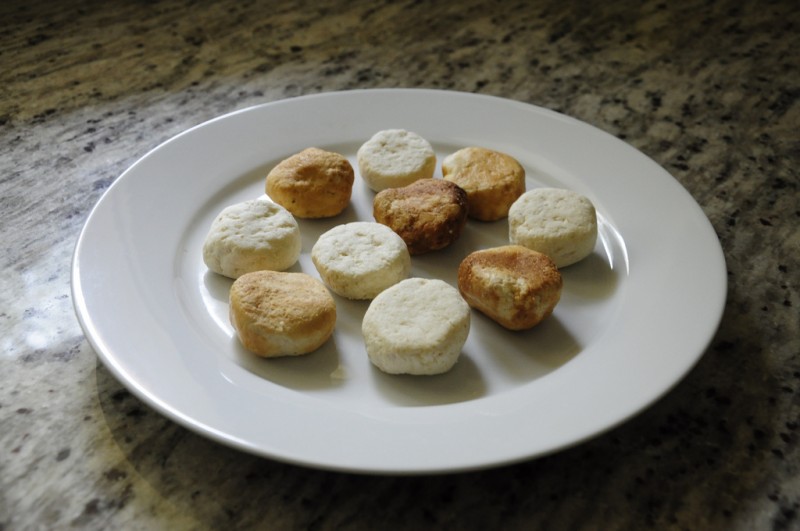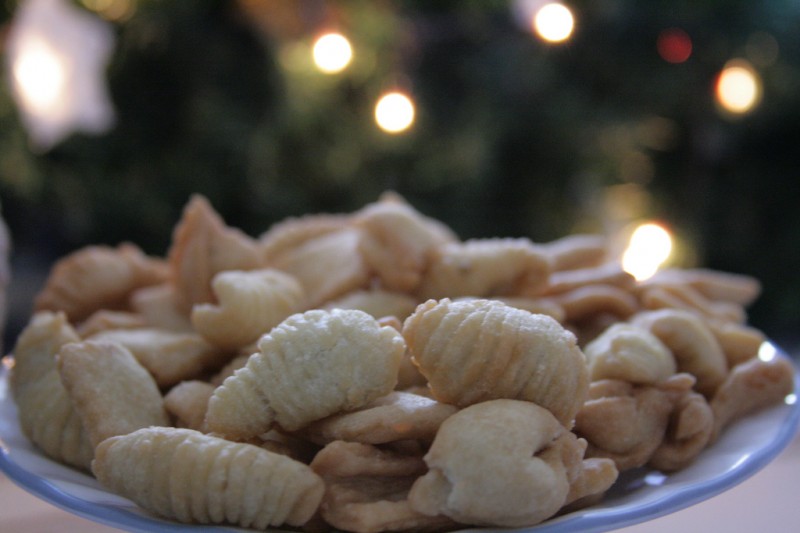ポルトガル人がインドに植民地を築いたのは16世紀初頭である。 ポルトガル領インド が最初に統治下に置いたのはコーチンだが、その支配は後にゴアへと移った。 ポルトガル人による支配は、その後4世紀にわたってインド西岸を中心に各地へと広がり、同時にインド北東部のベンガルへも及んだ。
この間ポルトガル人は、いくつかのインド料理に二つの方法でその痕跡を残した。一つはインド料理に新たな食材―今日のインド料理には不可欠と考えられている 香辛料 を含む―を導入したこと、そしてもう一つはインド料理の調理法と味覚に合わせたポルトガル料理をインドに導入したことである。
ゴアは1961年までポルトガルの支配下にあったため、当然その影響は最も強い。特に ゴアのカトリック教徒の料理には、はっきりとしたポルトガルの特色が見られる。ブロガーのHilda Mascarenhasは有名なゴア料理であるpork vindalooについて次のように述べている。
The name “Vindaloo” is derived from the Portuguese dish “Carne de Vinha d’Alhos” which is a dish of meat, usually pork, with wine and garlic. The Portuguese dish was modified by the substitution of vinegar (usually palm vinegar) for the red wine and the addition of red Kashmiri chillies with spices, to evolve into Vindaloo. The alternative terms are Vindalho or Vindallo. Traditional Goan Pork Vindaloo is intensely flavored with fragrant spices and does not include potatoes. No celebration and festive occasion is complete without the Goan Pork Vindaloo. It is enjoyed with the most popular and loved accompaniment, Goan sannas, which are prepared with toddy! This speciality is served with pride in every Goan home at Christmas, New Year and Easter.
「Vindaloo」という名前は肉(一般的には豚肉)と赤ワイン、ニンニクを使ったポルトガルの肉料理「Carne de Vinha d'Alhos」に由来します。このポルトガル料理の赤ワインが酢(一般的にはヤシ酢)に代わり、さらにカシミールチリと香辛料を一緒に加えることでVindalooへと進化しました。 別名VindalhoやVindalloとも言われます。伝統的なゴアのPork Vindalooは香り高い香辛料が効いた味付けで、じゃがいもは入っていません。 ゴアではPork Vindalooなくして祝祭や祝いの行事は成り立ちません。 Pork Vindalooはトディー(訳注:ココヤシの樹液で作る醸造酒)が入ったゴアのsannas(訳注:トディーを使って発酵させた蒸し米のケーキ)と一緒に食べるのが最も一般的で人気があります。この名物料理はクリスマスや新年、イースターの時にゴアのそれぞれの家庭ご自慢の料理として出されるのです。
Gavin Harveyは次のように付け加える。
Vindaloo started as a vinegar and garlic based stew made with pork or other meat but when introduced to India it got revamped with various spices and chillies. Potatoes were also added to the dish and “alhos” became “aloo” (Hindi word for “potatoes”) – so soon people assumed potatoes were a necessary ingredient of this dish.
Vindalooは豚肉、もしくは他の肉を酢とニンニクで煮込んだ料理として始まったが、インド国内に伝わるとさまざまな香辛料や唐辛子を使って改良されるようになった。ジャガイモも加えられ「alho」(訳注:ポルトガル語でニンニクという意味)は「aloo」(ヒンディー語でジャガイモという言葉)になった。そのうちに人々はジャガイモがこの料理に欠かせない食材だと思い込んだのだ。
ゴアの沿岸をずっと下ったところにマンガロールの町はあるのだが、マンガロールのカトリック教徒の料理 とゴアのカトリック教徒の料理には多くの共通点がある。ゴアとマンガロールで共通する肉料理にsorpotel(またはsarapatel)があるが、これは元々ポルトガルのアレンテージョ地方の料理である。 The Goan RecipesブログでGlennは次のように記している。
The word ‘sarapatel’ literally means confusion, probably referring to the mish-mash of ingredients of pork heart, liver and even pork blood!
「sarapatel」という言葉は文字通りには「乱雑」を意味する。おそらく材料である豚の心臓、肝臓さらには豚の血さえもごたまぜにしてしまうからだろう。
インドの反対側へ行くと、ベンガル料理の中にも同じくポルトガルの影響を感じさせるものがある。 Rangan Dattaはある特別なチーズの歴史について教えてくれる。
Originating from the erstwhile Portuguese settlement of Bandel (about 50 km north of Calcutta), Bandel Cheese is perhaps one of the last traces of Portuguese cuisine in Bengal. The Portuguese influence in Bengal dates back to the late 16th century. Almost a century after Vasco da Gama reached the West Coast of India the Portuguese started making their inroads into Bengal. […] It was the probably the Portuguese who introduced the art of cheese making in Bengal and in spite of all odds the technique has survived over centuries. The Bandel Cheese introduced by the Portuguese was probably made by the Mogh (Burmese) cooks under Portuguese supervision. […] This variety of unripened cheese is made from cows milk and comes in two versions plain and smoked. First the the curd is extracted from the cows milk by using lemon juice. The cheese is then shaped and drained in perforated pots. The plain variety is of milk-white colour and comes in disc shapes of about an inch diameter and quarter of inch thickness. The smoked variety comes in the same shape and size but has a crispy brownish crust covering the soft milk-white interior.
かつてのポルトガル入植地であるバンデル(カルカッタの北およそ50キロに位置する)を起源とするBandel cheeseは、ベンガルにおけるポルトガル料理の最後の名残の一つだろう。ポルトガルがベンガルに影響を与えたのは16世紀末にまで遡る。ヴァスコ・ダ・ガマがインド西岸に到着したおよそ1世紀後に、ポルトガル人たちはベンガルへと進出し始めた。[中略]ベンガルにチーズの製造技術を伝えたのはおそらくポルトガル人であり、幾多の困難にも関わらず、その技術は何世紀にもわたって生き残ってきた。ポルトガル人が伝えたBandel cheeseは、彼らの監督下で働いていたモグ族(ビルマ人)の料理人たちが作っていたようだ。[中略]この非熟成タイプのチーズは牛乳を原料としており、プレーンタイプと燻製タイプの二種類がある。まず始めにレモンジュースを使って牛乳から凝乳を取り出す。次にそれをひとまとめにして小さい穴の空いた容器にいれ、水を切る。プレーンタイプは牛乳の白さそのままで直径約1インチ、厚さ1/4インチの円盤型である。燻製タイプはプレーンタイプと形とサイズは同じだが、パリっとした食感の茶色がかった外皮が白くてやわらかい中身を覆っている。
Zoe Perrettの記述
The Portuguese influence on Bengal was not pure. Having gone to Goa first, many of the new introductions were delivered with a distinct Western Indian accent, or, indeed, were dishes the Portuguese purloined directly from that small state. The Portuguese also proffered Bengal bounty from travels further afield; fruity beauties like pineapple, papaya, guava, and the lychees from the Orient. Where Goa absorbed the influences, blending Portuguese techniques and dishes with local spices, in Bengal, many of the Portuguese-provided ingredients have retained their own clear identity. Mogh cooks soon mastered Western baking methods; displayed today in Calcutta’s prolific puffs and pastries, and perhaps also in the use of white flour for ‘luchis’ (a Bengali bread).
ポルトガル人がベンガルに与えた影響は純粋なものではありませんでした。まずゴアを通ってきたことから、新たに伝えられたものの多くは西インドの特徴と共に伝えられました。言いかえれば、ベンガルに伝えられたものの多くは、その小さな州ゴアからポルトガル人が直に盗んできた料理の数々であるとも言えるのです。またポルトガル人は、遥か遠くの旅路からの贈り物をベンガルにもたらしました。パイナップルやパパイヤ、グァバ、東洋からのライチといった好奇心をくすぐる魅力的な品々です。ポルトガルの影響を受け入れたゴアでは、ポルトガルの調理法やポルトガル料理が地元の香辛料と融合しました。これに対してベンガルではポルトガル人が持ち込んだ食材の数々そのものが、その明らかな特徴を維持してきたのです。モグ族の料理人たちは西洋のパンを焼く方法をすぐに習得しました。今日のカルカッタの豊富なケーキやペストリー、そしておそらく「luchis」(ベンガルのパン)の漂白小麦粉の使い方にもその影響が現れています。
ポルトガル人はインドに食事用の料理だけでなく、甘いお菓子の遺産も残した。Kulkuls、またはKidyoはゴアとマンガロールのカトリック教徒たちがクリスマスに食べるお菓子の一種である。Aparna Balasubramaniamはその特徴を次のように述べている。
Kulkuls are made by deep-frying inch long bits of sweet dough moulded/shaped into small curls (like butter curls) which are often also coated with a sugar glaze which dries out. The kulkuls tend to resemble small worms, hence the name “Kidyo” in Konkani, the language spoken in Goa. If you do not to think of them as “worms” you can think of them as shell-shaped. I like to think that the name Kulkul/Kalkal comes from the rattling sound of these little treats jostling one another when they’re shaken in sugar syrup or maybe in the tin in which they would be stored. Kulkuls are made during Christmas in Goa and are an important item in the Kuswar (a collection of Goan Christmas-time treats), and are distributed to neighbours. They’re also taken along to give away during “obligatory” visits to friends and family. […] Someone pointed out the Kulkuls are actually a variation of the Portuguese Filhoses Enroladas, which is a roll or curvy noodle-shaped Christmas-time sweet that is deep-fried and sugar-glazed. So it is possible that Kulkuls were brought to India by the Portuguese.
Kulkulsは、ひとつまみの甘いパン生地を小さくカールして(バターカールのように)たっぷりの油で揚げたものです。さらに砂糖シロップをまとわせてから乾燥させることもあります。Kulkulsは小さな虫に似てしまいがちなことから、ゴアで使われている言語であるコンカニ語では「Kidyo」(訳注:コンカニ語で虫を意味する)と呼ばれています。もし「虫」なんて想像したくなければ貝の形を思い浮かべて下さい。私としては、このKulkul/Kalkalという名前は、その小さなご馳走が砂糖シロップの中やお菓子が収められる缶の中で揺すられる時に、互いに触れ合いガラガラと音をたてるところから付けられたのだと思いたいのです。Kulkulsはクリスマスの期間中にゴアで作られるKuswar(ゴアのクリスマスに用意されるご馳走の数々)の中でも重要なお菓子の一つであり、隣近所にも配られます。またそれらのお菓子は、友人や家族のところに「お約束」の訪問をする時に配るために持参されることもあります。[中略]Kulkulsは、実はポルトガルのFilhoses Enroladasが変化したものだと指摘する人もいます。Filhoses Enroladasは巻いてあるか、平たくカーブさせた形の生地をたっぷりの油で揚げて砂糖をまぶしたもので、クリスマスの時期に食べるお菓子です。そう、Kulkulsはポルトガル人がインドに持ち込んだ可能性があるのです。









